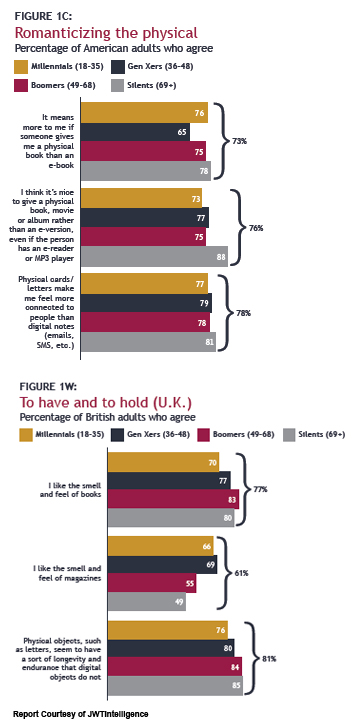Written by Bill Michael
eMarketing Manager, Xerox Corporation

So lately you’ve found yourself pulling out old vinyl records, thumbing through family photo albums, and dusting off old stationery to craft hand-written notes? No need to worry – you aren’t alone! In fact, your actually in very good company. According to an interesting article that appeared on FastCompany earlier this week, which detailed a trend report conducted by marketing communications brand JWT and Frank Rose, 79% of adults agree that they oftentimes miss having memories in physical form, such as photos, letters, or books. The report validates something we’ve all felt at one point or another: in the ever-changing digital world that we all live in, we find ourselves placing increasing value on the moments that do not involve us staring at a screen – you know, the time we spend with real people and real things!
This is not to be confused with a notion that people are abandoning digital technology in herds – because, let’s face it, that won’t be happening anytime soon. But as the JWT report describes it, “as digital screens become our default interface with the world, we seem to increasingly seek out physical objects and experiences.” This was illustrated through a survey conducted in the US and UK that included 1,200 adults, aged 18 and older. Interestingly, the results strongly supported that this romanticizing of the physical, tangible objects in our lives was consistent across all generations, including Millennials (18-35), Gen Xers (36-48), Boomers (49-68) and Silents (69+).
A look at some statistics from the report helps us easily draw connections to the value of print in today’s e-everything world. Physical objects, including printed pieces, embody attributes that are highly valued across all ages – they are tactile and tangible, symbolize meaning, elicit emotional sentiments, and exude longevity. According to the report, this holds true no matter the generation – from Silents (69+) where physical, offline objects have always been a part of their lives, to the Millennials (18-35) who have grown with the rising prevalence of digital technologies.
The JWT report looked at common activities performed by adults, analyzing each to see what percentage was done either online or offline. It found that while 59% of American adults go online to read their news (55% British adults), the reading of books is done largely offline (67% of American adults, 74% of British adults). Meanwhile, 73% of American adults and 80% of British adults agreed that receiving a physical book from someone is more meaningful than receiving an e-book – and it’s interesting to note that Millennials were amongst the highest of the generations to agree. Similarly, 73% of American and 83% of British adults said they’d prefer to give someone a physical book, album, or movie over an e-version of the same item, even if the recipient had an e-reader or MP3 player. The smell and feel of books was something 72% of American (77% of British) adults enjoyed, and when asked what physical items would be missed the most if they were to disappear – printed books led the way among survey responders.
What does this all mean? It shows our constant connection in today’s e-world acutely enhances our awareness of the qualities that make physical, offline experiences unique. This not only creates a desire for us to incorporate those experiences back into our lives, but also generates unique opportunities to bridge the digital and physical worlds. These opportunities exist in many forms – print fulfillment pieces, photo books, printed cards, personalized DM campaigns, and incorporation of digital technologies into printed pieces (IKEA’s use of Augmented Reality into its yearly product catalog, and posters promoting the launch of Halo 4 and using Near Field Communications, turning a printed piece into a city-wide scavenger hunt, both come to mind as good examples)…as well as many, many others.
The JWT report showed 73% of American adults (78% British) stated that they find themselves wanting to turn their digital memories into physical keepsakes – providing a tangible record of them. The report also revealed that physical cards and letters made 78% of American and 81% of British adults feel more connected to people than digital notes and emails (explaining why an eCard company, Paperless Post, began offering printed versions of their digital cards when more than half their online customers requested the service).
The opportunities are there, and there is sufficient support to back it up. As you emerge yourself more and more in today’s digital world, do you find yourself wanting to embrace with offline, traditional formats? What role do you see print playing, and in what ways do you see print helping to bridge the digital and physical worlds?
Interested in similar topics? You may want to check out:
4 Comments
Comments are closed.



Nice Post……….
Thanks for this
Thanks for the feedback – glad you found the post useful!
Bill (Xerox Employee)
Great article! As a millennial, I find many of my friends are discovering the difference between print and digital. I read all my news online, but prefer physical books. In fact, one of my prized possessions is a book signed by my favorite author, Hunter S. Thompson. Meeting him and having something tangible to remember the experience with is priceless. You can’t get an autograph on an e-book.
Katherine – I couldn’t agree more – there is a time and place for both physical and digital, as each provides unique benefits. I found the study and the findings to be really interesting, as it revealed the sentimental gap that digital has a difficult time filling. I myself am an avid sports fan, and some of my favorite possessions are photographs of players from my childhood. Nothing digitized could ever recreate the feelings of dusting off the photos and reliving those memories!
Bill (Xerox Employee)